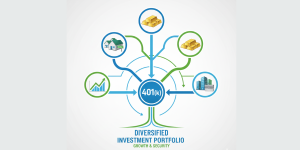Retirement goes hand-in-hand with financial planning and investments. This is because managing and growing your money properly is key to achieving your financial goals and fulfilling your desires. The intersection of financial planning investment strategies becomes increasingly critical as individuals approach their retirement years, requiring a sophisticated understanding of both short-term financial management and long-term wealth accumulation techniques.
Whether you prioritize exploring new interests or spending more time with family after retiring, here are four steps to fund all expenses during your retirement. These comprehensive financial planning investment approaches will help you navigate the complex landscape of retirement preparation, ensuring that your golden years are financially secure and aligned with your personal aspirations.
The modern financial planning investment environment presents both unprecedented opportunities and unique challenges. With increasing life expectancy, inflation concerns, and evolving economic conditions, today’s retirees must be more strategic than ever before. A well-structured financial planning investment framework addresses multiple facets of retirement preparation, including tax optimization, risk management, healthcare costs, and legacy planning.
The Key Steps To Financial Planning Investment
Here are the main steps to consider.
Step #1: Create a Comprehensive Financial Plan
A comprehensive financial planning and investment strategy serves as your roadmap to attaining your financial goals. While it doesn’t necessarily have to be carved in stone, it is the perfect starting point that forecasts your money flow. Effective financial planning investment methodologies begin with a thorough analysis of your current financial position, including assets, liabilities, income streams, and expenses.
When creating a financial plan, consider what type of lifestyle you want during retirement. Think about your dependents, your life expectancy, and which assets you’ll pass on to family and friends. Referencing an estate planning checklist can help you gain a broad perspective and create strategies that will put your plan into motion. Your financial planning investment blueprint should account for various retirement phases, from early retirement activities to potential long-term care needs.
Your financial plan must contain forecasts, assumptions, and expected results. Over time, don’t forget to update it based on the changes in your life. A robust financial planning investment strategy incorporates stress testing scenarios, allowing you to understand how market volatility, economic downturns, or unexpected life events might impact your retirement security.
The foundation of successful financial planning investment lies in establishing clear, measurable objectives. These might include replacing a specific percentage of your pre-retirement income, maintaining your current standard of living, or achieving particular lifestyle goals such as travel or philanthropy. Your plan should also address inflation protection, ensuring that your purchasing power remains intact throughout your retirement years.
Modern financial planning investment tools and technology can significantly enhance the planning process. Sophisticated modeling software can project various scenarios, helping you visualize the potential outcomes of different savings rates, investment allocations, and retirement timelines. These technological advances make it easier than ever to create detailed, data-driven financial plans that adapt to changing circumstances.
Step #2: Develop Investment Strategies and Tactics
Create strategies based on your financial goals. For instance, if you prioritize avoiding costly hospital bills, consider securing health insurance coverage as soon as possible. Additionally, understanding IRS retirement plan guidelines can help you maximize tax-advantaged savings opportunities. Another effective tactic to save money is to refinance your mortgage to attain lower rates and monthly payments.
It’s also important to create specific tactics that can be considered as executable action items. Depending on your goals, other professionals such as your mortgage broker, tax accountant, or estate attorney can carry out these strategies. Successful financial planning investment requires a coordinated approach among various financial professionals to ensure all aspects of your financial life work harmoniously together.
Asset allocation forms the cornerstone of effective financial planning investment strategies. This involves determining the optimal mix of stocks, bonds, real estate, and alternative investments based on your risk tolerance, time horizon, and financial objectives. A well-diversified portfolio can help protect against market volatility while positioning you for long-term growth.
Tax-efficient financial planning investment strategies can significantly impact your retirement wealth accumulation. This includes maximizing contributions to tax-advantaged accounts such as 401(k)s, IRAs, and Roth IRAs, as well as implementing tax-loss harvesting and strategic asset location techniques. Understanding the tax implications of different investment vehicles and withdrawal strategies can save thousands of dollars over the course of your retirement.
Risk management is an integral component of comprehensive financial planning investment approaches. This encompasses not only investment risk but also longevity risk, inflation risk, and sequence of returns risk. Implementing appropriate insurance coverage, including life, disability, and long-term care insurance, can protect your financial plan from unexpected setbacks.
Alternative investment strategies can enhance traditional financial planning investment portfolios. These might include real estate investment trusts (REITs), commodities, or even international markets allocations for appropriate investors. However, these should be carefully evaluated within the context of your overall risk profile and investment objectives.
Step #3: Work with a Financial Advisor
Before investing, determine your goals and consider your age, risk appetite, and desired investment amount. The Department of Labor provides valuable resources on retirement savings and investment best practices. Investing can be tricky for inexperienced investors. If you are unsure how to get started, consider working with a financial advisor who can help you make the right investment decisions.
Professional financial planning investment guidance becomes invaluable when navigating complex financial markets and regulatory environments. A qualified financial advisor brings expertise in portfolio construction, tax planning, estate planning, and retirement income strategies that individual investors may find challenging to master independently.
When selecting a financial advisor for your financial planning investment needs, consider their credentials, experience, fee structure, and investment philosophy. Look for professionals who hold relevant certifications such as Certified Financial Planner (CFP), Chartered Financial Analyst (CFA), or Personal Financial Specialist (PFS). These designations indicate a commitment to professional education and ethical standards.
The advisor-client relationship in financial planning investment should be built on transparency, communication, and shared objectives. Your advisor should provide regular portfolio reviews, market updates, and strategic recommendations based on changing market conditions and personal circumstances. They should also be accessible for questions and concerns throughout your financial journey.
Technology integration has revolutionized how financial advisors deliver financial planning investment services. Modern advisory platforms offer real-time portfolio monitoring, sophisticated analytics, and streamlined communication tools that enhance the client experience. However, the human element remains crucial for providing personalized guidance and emotional support during volatile market periods.
Fee transparency is essential when engaging financial planning investment professionals. Understand whether your advisor charges fees based on assets under management, hourly rates, flat fees, or commissions. Each fee structure has its advantages and potential conflicts of interest, so choose the arrangement that best aligns with your needs and preferences.
Step #4: Monitor and Adjust Your Financial Plan
Your financial plan that used to work years ago might not be effective today. This is especially true if you experience many life changes. A death in the family, a job change, and a new child are major events that might cause changes in financial priorities and demand adjustments in your financial plan. It’s also important to monitor your Social Security retirement benefits and understand how life changes may impact your future income.
Additionally, the financial planning process does not end as soon as you are done investing. Check the funds regularly to ensure they are performing as expected. To ensure your strategies are still useful in attaining your financial goals, monitor and evaluate the changing conditions and re-balance your accounts as needed with a certified financial planner.
Regular monitoring of your financial planning investment strategy should include performance evaluation against established benchmarks and peer comparisons. This analysis helps identify whether your investments are meeting expectations and if any adjustments are necessary to stay on track toward your retirement goals.
Market conditions and economic environments constantly evolve, requiring periodic adjustments to your financial planning investment approach. What worked during a bull market may not be appropriate during economic uncertainty or rising interest rate environments. Staying informed about market trends and their potential impact on your portfolio is crucial for long-term success.
Life stage transitions significantly impact financial planning investment strategies. As you progress from accumulation to preservation to distribution phases, your investment allocation and risk tolerance should evolve accordingly. Young professionals might emphasize growth-oriented investments, while those approaching retirement may shift toward more conservative, income-generating assets.
Technology can streamline the monitoring process for your financial planning investment portfolio. Many platforms offer automated rebalancing, performance reporting, and alert systems that notify you of significant market movements or portfolio deviations. These tools can help maintain your target asset allocation without requiring constant manual oversight.
Annual financial planning investment reviews provide opportunities to assess progress, update assumptions, and make necessary course corrections. These comprehensive evaluations should examine investment performance, tax efficiency, insurance coverage, estate planning needs, and overall progress toward retirement objectives.
Start Your Financial Planning and Investment Journey
Just because your retirement may be several decades in the future does not mean you shouldn’t worry about it right now. Remember that anything can happen at any time. This is why it’s wise to prepare ahead, and the best time to plan for a comfortable retirement is as early as today. To increase your chances of having adequate funds for retirement and enjoying peace of mind, follow this guide with help from a trusted Financial Planner in Charlotte.
The power of compound interest makes early engagement in financial planning investment particularly valuable. Starting your retirement savings and investment journey in your twenties or thirties can result in significantly more wealth accumulation than delaying until your forties or fifties, even with smaller initial contributions.
Education and continuous learning about financial planning investment principles will serve you well throughout your career and retirement. Stay informed about changes in tax laws, retirement regulations, and investment opportunities that could impact your financial strategy. The financial landscape is constantly evolving, and successful investors adapt to these changes.
Take a step closer toward your desired retirement by working with CALAMITA WEALTH MANAGEMENT, an investment advisor in Charlotte, NC. As a Charlotte Financial Advisor Firm, we can help protect you from financial uncertainties through comprehensive financial plans tailored to your needs and goals. Schedule a consultation today!
Embarking on your financial planning investment journey requires commitment, patience, and professional guidance. The strategies and principles outlined in this guide provide a solid foundation for building long-term wealth and achieving retirement security. Remember that successful financial planning investment is not about timing the market or finding perfect investments, but rather about consistent saving, diversified investing, and staying committed to your long-term objectives.







